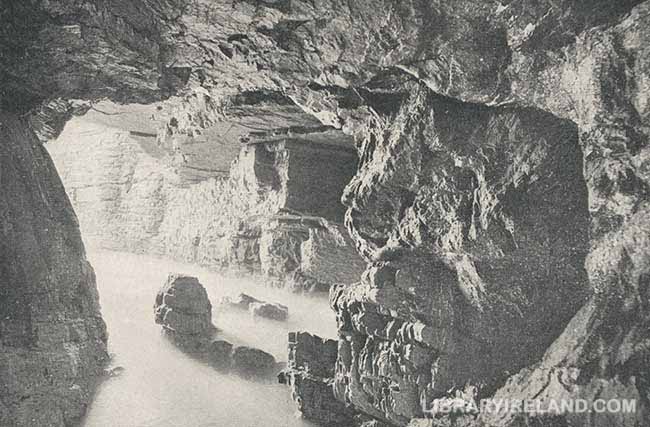The Seven Arches, Port Salon
We stayed overnight, and made an excursion next morning to the "Seven Arches." This is a short and interesting trip, about a mile and a half north of the hotel. Here is a series of fine caverns scooped out of the limestone rock by the action of the waves, which can be easily reached by land, but the approach by water is grander and more imposing. From the strand where the boat deposits the visitor, a cave with a narrow entrance runs one hundred and thirty feet inland, and beyond this are the "Seven Arches," one of which, forming a grand entrance from the sea, one hundred yards long, divides into two. Beyond the left-hand cave is another, one hundred and twenty feet long. The right-hand cave is again divided into four beautiful caverns, through any one of which a passage may be made to the bowlder strand, whence another arch leads towards the north.

In the Great Arch, "Seven Arches," Port Salon, County Donegal
We left Colonel Barton's and drove along the coast for a few miles to Doaghbeg, where we stopped to admire a magnificent sea-arch called "Brown George," the most remarkable natural feature, perhaps, on the whole coast of Lough Swilly. Doaghbeg is a very primitive, native village and is the capital of the district called Fanet (sometimes Fanad). This was the birthplace of the Honorable P. C. Boyle, who has made his mark in Pennsylvania. Further driving brought us to Fanet Head, one of the most northerly points in Ireland, on which is erected a large light-house, one hundred and twenty-seven feet above high-water. This has a group of occulting lights showing white to seaward and red towards land. After inspecting the lighthouse, we took our last look at Lough Swilly, that lake of shadows with its marvellous scenic splendor, almost unrivalled also as a safe and deep harbor. I have seen the British fleet manoeuvered in its confines, and it could easily anchor every man-of-war in commission to-day, giving them all enough cable to swing clear of one another on the tide.
Read "On an Irish Jaunting Car through Donegal and Connemara" at your leisure
Read On an Irish jaunting Car through Donegal and Connemara at your leisure and help support this free Irish library.
Samuel Gamble Bayne was born in Ramelton, County Donegal, and educated at Queen's University in Belfast. At the age of twenty-five he left for America with a view to making his fortune. He invested in an oil well in Pennsylvania and later founded a bank which subsequently came to be the JP Morgan Chase bank in New York. By the time this book was written he was wealthy enough to be referred to as a billionaire. His account of the tour through the north, west and south of Ireland is a pleasant snapshot of how that part of the country was in the early part of the 20th century. He describes what is to be seen, gives some background history and, through the illustrations especially, provides wonderful glimpses of the area's social history.
The ebook is available in .mobi, .epub, and .pdf formats. See details ».

